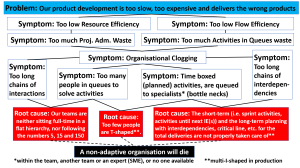In this blog post we will now reveal the two last symptoms of Organisational Clogging, which regards too long chains. We have too long chains of interactions and too long chains of interdependencies.
If we continue with filling in our Prefilled Problem Picture Analysis Map, with these two last symptoms for Organisational Clogging, it will look like this, where we also add the root cause “Our working teams are not sitting in as flat hierarchy as possible”, that is valid when people work in projects, teams and team of teams and other constellations.

Too long chains of interactions are most common in silo organisations, but also happens in Agile Development organisations, and here are some examples of when too long chains of interactions easily happen, meaning a lot of intermediaries and of course also the Chinese Whispers [1] as an unwelcome add-on:
- to get in contact with the customer/end user – this will induce difficulties to understand what the customer wants. And the customers do not know what they can have, makes it very difficult to make short iterations too achieve fast feedback in order to understand the customers’ need and leave the Complex domain.
- to take decisions – a chain of decisions can anytime be stopped, or a decision reversed, making a lot of wasted time for everyone involved. And if the decision is too late, the Flow Efficiency will be also be affected.
- to solve an interdependency – when the interactions must follow many intermediaries in the hierarchy, even if the interdependency is easily seen, and maybe also easily solved.
In Lean Product Development, the team’s close connection to the customer and the understanding of the customer make them taking care of the interactions and make the chains of interactions very short. Many times, the Shusa (Chief Engineer) drives the car where the customer drives, packaging the car like the customer, eats breakfast in the car if the customer does this, etc. making the interaction chain between the customer and the designer extremely short. This in turn gives the possibilities to have iterations with very fast feedback loops.
Regarding the chains of interactions for decisions for example, Toyota many times can have long chains, but they compensate it with very short time of the actual interactions. When the decision finally is taken, it is also more of a formal decision through consensus; the work has already started long time ago, because everybody already know everything about the decision to be taken.
All this make them have no problem with the bad planning of the usage of people root cause.
Regarding the too long chain of interdependencies, it may not be that common, but will emerge when the activities are made unnecessarily small. Setting the size of the activity strongly depends on the domain we currently are in, and the more certain we are, the longer activities we can allow, which will be handled in a later blog post.
Next blog post is the wrap-up of this series about Organisational Clogging. C u then.
References
[1] Chinese whispers. Link copied 2018-09-14.
https://en.wikipedia.org/wiki/Chinese_whispers

